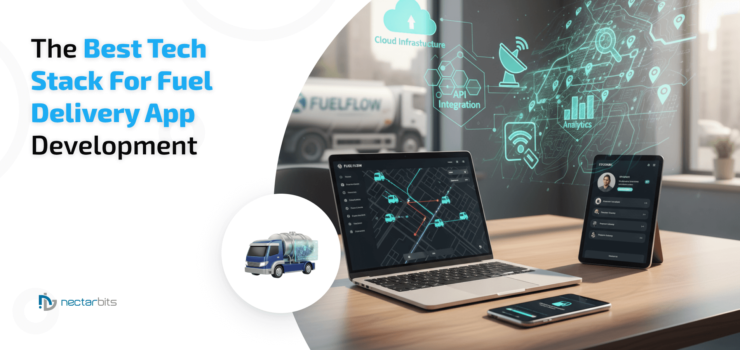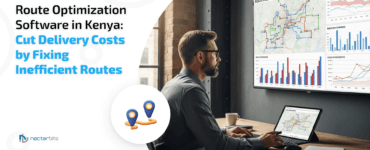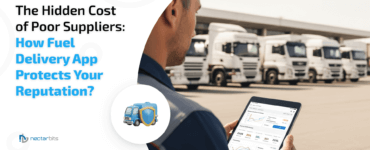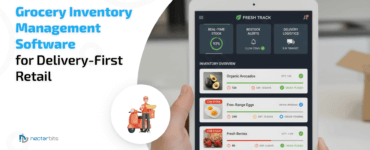How do you choose a tech stack for Fuel Delivery Apps Development?
When you get an app idea, you do a lot of research on a niche market, target audience, marketing, and increasing downloads to turn it into a real app that generates billions of dollars. Have you ever thought of one thing- the mobile app with which you are trying to catch maximum tech-savvy eyeballs? They expect the mobile app to leverage AI, IoT, and sustainability features to perform to the notch? That’s where the modern tech stack plays a vital role.
Alas! In the rat race, the entrepreneurs forgot to research the technology aspect. It results in making the app fail, not performing as expected, or being full of bugs and crashes. The technology stack had a great impact on the mobile app development, such as
- It determines the app’s robustness.
- It defines whether the app can scale to OS versions higher or not.
- It ensures scalability depending on the business growth.
- It accelerates app development and reduces turnaround time.
- It enables app enhancements at speed to dynamically respond to changing market trends.
- It facilitates intuitive UI development that makes the users thrive.
All of these together can make or break the reputation of your business that has started spreading its wings into the digital era. There is a need to choose the modern tech stack that keeps your app up-to-date and trending.
The on-demand fuel delivery app is one of the modernized solutions that’s in demand. The government has enforced certain regulations that fuel delivery apps have to meet to stay in compliance as they are delivering the combustible commodity that needs to be handled and delivered with utmost care. Then, how can you miss the mark for fuel delivery app development with ian mperfect technology stack selection?
With a deep understanding of fuel delivery mechanism that involves GPS, tracking system, navigational structure, and more, our technical experts have created the best tech stack which makes your fuel delivery app development future-proof.
Let’s dive in!
Frontend Development- The Front Face of the Mobile App
It’s a beautiful interface of the application that appears to the users with which the users interact. There are different tools, such as CSS3, HTML5, JavaScript, and Web Assembly, and platforms available that enable the best-in-class frontend development.
Besides, the UI should be simple and packed with necessary design elements that allow users to easily book fuel deliveries. The app should not be loaded with so many graphics else it hurts the app’s performance. Strike a fine balance that ensures a wow experience delivery.
Backend Development- The Engine That Fuels the Fuel Delivery App
The backend is the true engine that powers your app; it supports everything from user authentication, storage, business logic, and data security to real-time operations such as GPS tracking. In fuel delivery app projects, the backend is particularly critical as it must also manage regulatory compliance, safety controls, and reliability; all of which form the backbone of a successful mobile app development strategy.
- Programming Languages & Frameworks: Node.js (Express / NestJS), Python (Django or Flask), Java (Spring Boot), depending on scale and developer expertise.
- Databases: Use relational databases (PostgreSQL, MySQL) for transactional data like orders/bookings/payments; NoSQL (MongoDB, DynamoDB) for flexible/unstructured data (logs, user telemetry). Sometimes a hybrid approach works best.
- Microservices or Modular Monoliths: Helps to scale individual parts (tracking, payments, notifications) independently.
- APIs & Integration: RESTful or GraphQL for frontend-backend communication; external services for maps, payments, SMS, etc.
- Security & Compliance: Encrypt data at rest and transit; secure authentication; compliance with local laws/regulations for fuel handling; regular vulnerability assessment.
- Monitoring & Performance: Logging, error reporting, load testing, ensuring low latency for GPS updates, and high uptime.
Development Platform- That Comes In Variety
The development platforms serve as the base that allows the organizations to build, test, and market the applications that work on different types of devices- mobile, tablet, and desktop, and platforms such as Android, iOS, windows, and others. There are various ways- native development, hybrid development, cross-development, and others to build the app for various types of devices and platforms.
Tech Stack for Fuel Delivery App for Native- known for high performance
The native development is known for the high performance, robustness, and better results it yields. It allows the developers to integrate the device’s in-built features such as camera, GPS, and others without relying on third-party APIs and external resources. Native apps are mainly best for two platforms- iOS and Android.
Tech Stack for Fuel Delivery App in Android
Kotlin and Java programming languages are used for building Android apps natively. Java is the oldest kid on the technology block, but Kotlin is new and considered as more stable as compared to Java. Besides, Kotlin fills the void that exists in Java such as limitations with Android API design, heavy, and cumbersome.
Read more: White-label Taxi Application Vs. Custom-Built App ?
Android studio toolkit is preferred by the developers due to code editing, debugging, instant deployment, and performance tooling it provides, which makes high-quality app development a breeze. Android developer tools provide support beyond Android-specific coding that includes- graphical UI builder, emulators, on-device debugging tools, and test automation support.
Latest Android SDK is installed by the developers to make the app work on the specific device and set of features.
Tech Stack for Fuel Delivery App for IOS
Objective-C and Swift are the two programming languages that are leveraged for iOS app development. Objective-C is the oldest technology that’s known for dynamic runtime environments and object-oriented capabilities. On the other hand, Swift is functional, compatible, less error-prone, and provides inline support and dynamic libraries. It improves the app performance with libraries that are directly uploaded to memory, thereby diminishing the app’s size.
Apple Xcode toolkit helps in developing iOS apps with a range of resources- graphical editor, debugging tools, instruments, and documentation it provides.
IOS SDK links the app and the iOS platforms it runs on. It also allows the developers to build APIs leveraging libraries and other tools. There are special tools for Apple’s OS and different interfaces.
Read More : Build a successful ride-sharing app Like Gett, Juno
Hybrid app development technology stack you can consider
If you’re a startup aiming to launch quickly across both iOS and Android, hybrid or cross-platform tech stacks are excellent options. They allow you to share large parts of the codebase, reduce cost, and maintain faster release cycles. Some modern choices include:
- Flutter: Google’s framework offering high performance, expressive UI, and good plugin support for GPS, maps, and cameras.
- React Native: Widely adopted, large community, easier integration with native modules for advanced features.
- Ionic / Capacitor: For apps with more web-based UI, or where you can compromise a bit on performance in exchange for speed.
Considerations:
- GPS accuracy & map rendering may lag behind fully native apps in some edge cases.
- Plugin/third-party library support may be less mature for very specific fuel/safety regulations.
- Performance under heavy load (many concurrent GPS updates, real-time tracking) needs careful architecture.
Some add-ons- the additional requirements you may have
Essential APIs & Add-ons for Fuel Delivery Apps
To deliver a seamless experience and improve operational efficiency, every modern fuel delivery app should integrate a set of essential APIs and third-party add-ons. These not only enhance functionality but also improve performance, security, and user engagement across the ecosystem.
Here are the key integrations to consider:
- Google Maps / Mapbox:
Enables real-time vehicle tracking, route visualization, and accurate navigation for drivers and users. It’s also crucial for optimizing delivery routes and estimating fuel arrival times. - Stripe / Razorpay / PayPal APIs:
Power secure and seamless digital payments, support multiple currencies, and simplify checkout flows. These gateways ensure compliance with PCI DSS standards for financial transactions. - Twilio / Firebase Cloud Messaging:
Handle push notifications, SMS alerts, and OTP verification. These APIs help keep customers informed about order status, delivery updates, and safety confirmations in real time. - Analytics & BI APIs (Google Analytics, Mixpanel, Amplitude):
Track user behavior, delivery performance, and operational KPIs to help businesses make data-driven decisions. Integration with dashboards enables real-time insights into fuel demand patterns and customer satisfaction. - AI-Based Route Optimization Tools (OptimoRoute, Routific, OR-Tools):
Use machine learning algorithms to dynamically assign drivers, reduce idle time, minimize fuel consumption, and ensure timely deliveries even during high-demand hours.
Conclusion
Fuel delivery app development can take your business ROI to a higher level, but only if you use the right technology stack. That’s quite a task. Understanding this need, we have described the best tech stack for fuel delivery app development that ensures great performance, scalability, and robustness. If you have any doubts, feel free to consult our experts who have a great knack for on-demand fuel delivery app development. All the best!







